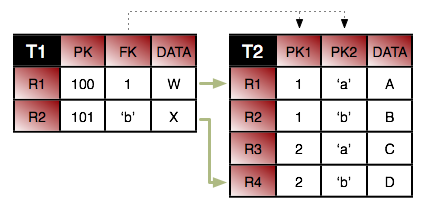The JPA Overview's Chapter 12, Mapping Metadata and the JDO Overview's Section 15.7, “Joins” explain join mapping in each specification. All of the examples in those documents, however, use "standard" joins, in that there is one foreign key column for each primary key column in the target table. Kodo supports additional join patterns, including partial primary key joins, non-primary key joins, and joins using constant values.
In a partial primary key join, the source table only has foreign key columns for a subset of the primary key columns in the target table. So long as this subset of columns correctly identifies the proper row(s) in the referenced table, Kodo will function properly. There is no special syntax for expressing a partial primary key join - just do not include column definitions for missing foreign key columns.
In a non-primary key join, at least one of the target columns is not a
primary key. Once again, Kodo supports this join type with the same
syntax as a primary key join. There is one restriction, however: each
non-primary key column you are joining to must be controlled by a
field mapping that implements the
kodo.jdbc.meta.Joinable interface. All built in
basic mappings implement this interface, including basic fields of
embedded objects. Kodo will also respect any custom mappings that
implement this interface. See
Section 7.10, “Custom Mappings” for an examination of
custom mappings.
Not all joins consist of only links between columns. In some cases you might have a schema in which one of the join criteria is that a column in the source or target table must have some constant value. Kodo calls joins involving constant values constant joins.
To form a constant join in JPA mapping, first set the
JoinColumn's name attribute to
the name of the column. If the column with the constant value is the
target of the join, give its fully qualified name in the form
<table name>.<column name>.
Next, set the referencedColumnName attribute to the
constant value. If the constant value is a string, place it in single
quotes to differentiate it from a column name.
To form a constant join in JDO mapping, first set the column
element's name attribute to the name of
the column. If the column with the constant value is the target of
the join, give its fully qualified name in the form
<table name>.<column name>.
Next, set the target attribute to the constant
value. If the constant value is a string, place it in single quotes
to differentiate it from a column name.

Consider the tables above. First, we want to join row
T1.R1 to row T2.R1. If we just
join column T1.FK to T2.PK1, we
will wind up matching both T2.R1 and
T2.R2. So in addition to joining T1.FK
to T2.PK1, we also have to specify that
T2.PK2 has the value a. Here is
how we'd accomplish this in mapping metadata.
JPA:
@Entity
@Table(name="T1")
public class ...
{
@ManyToOne
@JoinColumns({
@JoinColumn(name="FK" referencedColumnName="PK1"),
@JoinColumn(name="T2.PK2" referencedColumnName="'a'")
});
private ...;
}
JDO:
<class name="..." table="T1">
<...>
<column name="FK" target="PK1"/>
<column name="T2.PK2" target="'a'"/>
</...>
</class>
Notice that we had to fully qualify the name of column PK2
because it is in the target table. Also notice that we put
single quotes around the constant value so that it won't be confused
with a column name. You do not need single quotes for numeric
constants. For example, the syntax to join T1.R2 to
T2.R4 is:
JPA:
@Entity
@Table(name="T1")
public class ...
{
@ManyToOne
@JoinColumns({
@JoinColumn(name="FK" referencedColumnName="PK2"),
@JoinColumn(name="T2.PK1" referencedColumnName="2")
});
private ...;
}
JDO:
<class name="..." table="T1">
<...>
<column name="FK" target="PK2"/>
<column name="T2.PK1" target="2"/>
</...>
</class>
Finally, from the inverse direction, these joins would look like this:
JPA:
@Entity
@Table(name="T2")
public class ...
{
@ManyToOne
@JoinColumns({
@JoinColumn(name="T1.FK" referencedColumnName="PK1"),
@JoinColumn(name="PK2" referencedColumnName="'a'")
});
private ...;
@ManyToOne
@JoinColumns({
@JoinColumn(name="T1.FK" referencedColumnName="PK2"),
@JoinColumn(name="PK1" referencedColumnName="2")
});
private ...;
}
JDO:
<class name="..." table="T2">
<...>
<column name="T1.FK" target="PK1"/>
<column name="PK2" target="'a'"/>
</...>
<...>
<column name="T1.FK" target="PK2"/>
<column name="PK1" target="2"/>
</...>
</class>